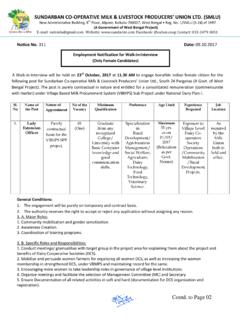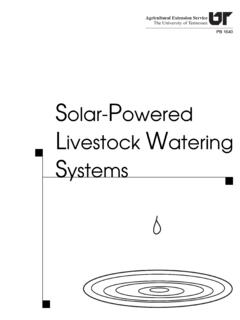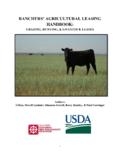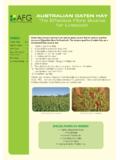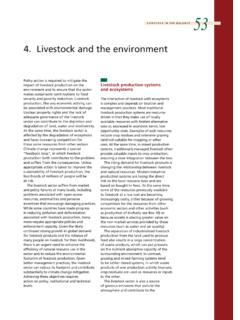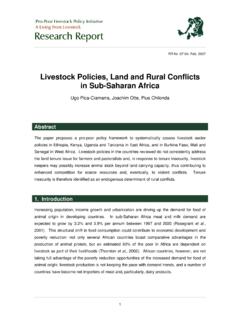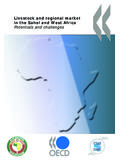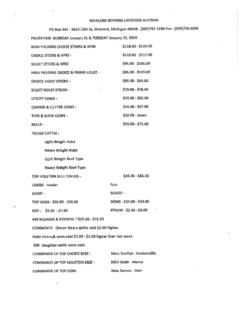Transcription of The Control of Neglected Zoonotic Diseases - who.int
1 The Control of NeglectedZoonotic DiseasesA route to poverty alleviationReport of a Joint WHO/DFID-AHP Meetingwith the participation of FAO and OIEG eneva, 20 and 21 September 2005 WHO/SDE/ cover: Children living with brucellosis United Republic of Tanzania. Photo: Sarah CleavelandThe Control of neglectedzoonotic diseasesA route to poverty alleviationReport of a Joint WHO/DFID-AHP Meetingwith the participation of FAO and OIEG eneva, 20 and 21 September 2005 Geneva, 2006 Zoonoses and Veterinary Public HealthDepartment of Food Safety, Zoonoses, and Foodborne DiseasesSustainable Development and Healthy W W W W World Health Organization 2006orld Health Organization 2006orld Health Organization 2006orld Health Organization 2006orld Health Organization 2006 All rights of the World Health Organization can be obtained from WHO Press,World Health Organization, 20 Avenue Appia, 1211 Geneva 27, Switzerland (tel.)
2 : +4122 791 3264; fax: +41 22 791 4857; e-mail: Requests forpermission to reproduce or translate WHO publications whether for sale or fornoncommercial distribution should be addressed to WHO Press, at the above address(fax: +41 22 791 4806; e-mail: designations employed and the presentation of the material in this publicationdo not imply the expression of any opinion whatsoever on the part of the WorldHealth Organization concerning the legal status of any country, territory, city or areaor of its authorities, or concerning the delimitation of its frontiers or lines on maps represent approximate border lines for which there may not yetbe full mention of specific companies or of certain manufacturers products does notimply that they are endorsed or recommended by the World Health Organization inpreference to others of a similar nature that are not mentioned.)
3 Errors and omissionsexcepted, the names of proprietary products are distinguished by initial capital reasonable precautions have been taken by the World Health Organization to verifythe information contained in this publication. However, the published material isbeing distributed without warranty of any kind, either expressed or implied. Theresponsibility for the interpretation and use of the material lies with the reader. In noevent shall the World Health Organization be liable for damages arising from its Library Cataloguing-in-Publication DataThe Control of Neglected Zoonotic Diseases : a route to poverty alleviation : report ofa joint WHO/DFID-AHP meeting, 20 and 21 September 2005, WHO Headquarters,Geneva, with the participation of FAO and - prevention and Control . medicine.
4 , Health Organization. Kingdom. Dept. for InternationalDevelopment. Animal Health 92 4 159430 6(NLM classification: WC 950)ISBN 978 92 4 159430 15 - WHO/DFID-AHP Meeting, September 2005 PrefaceiiiAs we enter the second phase of our attempt to meet the MillenniumDevelopment Goals, it is important to identify special areas where targetedinterventions can have a real impact in reducing poverty in households they affect both people and animals, especially where they involvelivestock, interventions to Control zoonoses require concerted action betweenthe veterinary and the human health sectors, while also offering substantialbenefits to both sectors. WHO has long taken the lead in bringing togetherinternational and national organizations to deal with the problems posed byboth emerging and endemic zoonoses.
5 Although much publicity has beenaccorded to the emerging Zoonotic Diseases , it is the endemic, and occasionallyepidemic zoonoses, which year in, year out affect poor livestock keepers inmarginalized communities. These Diseases were the focus of this , the DFID Animal Health Programme (DFID-AHP) has beenengaged in research on Zoonotic disease for two-and-a-half decades. It hasbecome increasingly obvious that the results obtained in the field of animalhealth need to be very firmly linked with the work being done on disease inhumans and this challenge has been enthusiastically taken up by theresearch , in order for the work being done on research and Control to have areal impact, it needs to achieve a higher profile and attract more substantialand long-term funding.
6 This meeting, organized jointly by WHO and DFID-AHP, brought together donors, researchers and those working on the controlof endemic zoonoses in three continents, to discuss the current situation,recent achievements and map out a way is our view that the Control of endemic Zoonotic Diseases offers a very realand highly cost-effective opportunity for alleviating poverty in remote ruraland marginalized peri-urban communities of poor livestock keepers. Thisreport outlines some of the reasons why, as seen by those involved inresearch on and Control of these MaudlinSusanne Weber-MosdorfManagerAssistant Director-GeneralDFID Animal Health ProgrammeSustainable DevelopmentCentre for Tropical Veterinary Medicine and Healthy EnvironmentsEaster Bush Veterinary CentreWorld Health OrganizationRoslin, Midlothian EH25 9RG20 Avenue AppiaScotland1211 Geneva 27 United KingdomSwitzerland6 Saving lives securing livelihoodsWHO/DFID-AHP Meeting, September 2005 -AcknowledgementsivWe would like to thank all those who participated in this meeting and whoprovided the background material and presentations from which this reportwas compiled.
7 Details of individual presentations can be found in theattached meeting agenda and these correspond to the relevant sections inthis report. Other sections are based on the working group reports and therecommendations were formulated at plenary sessions of the thanks go to Winyi Kaboyo for chairing the meeting, Maria VangJohansen for acting as rapporteur, and Marion Reverdin for the day-to-dayorganization of the meeting and for assembling an impressive dossier ofbackground material and abstracts. For those readers who are interested,the full dossier can be obtained by e-mailing her at thanks are also due to Alexandra Shaw for her tireless efforts infinalizing this comprehensive Neglected endemic zoonoses - WHO/DFID-AHP Meeting, September 2005 SummaryMeasures to safeguard human health and to Control disease in livestock andother animals for the prevention of the transmission of animal-borne orzoonotic Diseases are too often undertaken in isolation of one another.
8 Themeeting, organized jointly by the World Health Organization (WHO) and theAnimal Health Programme of the UK Department for InternationalDevelopment (DFID-AHP), showed the dual benefits to be gained by both theanimal and human health sectors by investing in the integrated andcoordinated Control of these meeting saw how, with more effective measures, we have the chance tosimultaneously save lives and secure livelihoods. Effective Control of zoonoticdiseases would mean a decreased disease burden, poverty reduction andincreased food supply for large numbers of the rural poor worldwide,thereby contributing towards the achievement of the MillenniumDevelopment Goals (MDGs) - Control measures already exist for several Neglected zoonoticdiseases such as rabies and brucellosis.
9 More integrated interventions canbe packaged through these existing structures. In certain cases, with theright programmes and adequate funding, this could lead to regional or evenglobal Control , or complete elimination of individual Diseases such as dograbies and echinococcosis in North Africa or brucellosis and echinococcosisin northern meeting recommended that the possible next steps to achieve anintegrated animal-human health approach should include: promoting the concept of one health by dealing with healthproblems in both people, their livestock and other domestic andwild animals they depend on through the development ofintegrated Control packages that address several disease/healthproblems; undertaking a number of measures to raise the profile of theneglected Zoonotic Diseases both internationally and within affectedcountries; systematically collecting data on the incidence of these diseasessupported by studies to estimate their dual burden on people andon livestock, quantify under-reporting and identify communitiesand groups at risk.
10 Investing in the development of new tools needed to effectivelycontrol these Diseases , particularly in the field of Neglected endemic zoonoses - WHO/DFID-AHP Meeting, September 2005viiContentsPreface------------------ ---------------------------------------- --------------- iiiAcknowledgements--------------------- ------------------------------------ ivSummary------------------------------- ---------------------------------------- vContents------------------------------- ---------------------------------------- - focus on endemic zoonoses? ---------------------------------------- we met ---------------------------------------- --------------------------- zoonoses matter ---------------------------------------- ---------------- and poverty--------------------------------- ---------------------- problem of under-diagnosis:why we see only the tip of the iceberg ---------------------------------- constituencies: medical needs andveterinary responsibilities------------------------ ------------------------- Control :a cost-effective opportunity for poverty alleviation ----------------- Neglected endemic zoonoses: some basic facts ------------- a dual burden into a dual benefit:brucellosis in Mongolia-------------------------------- ------------------- 1510.










